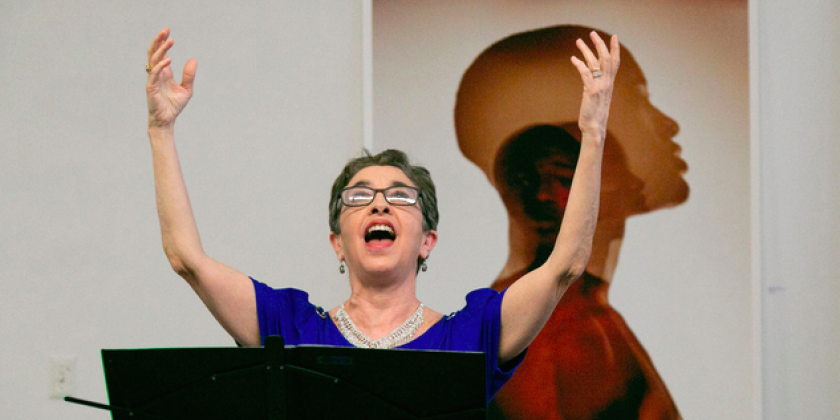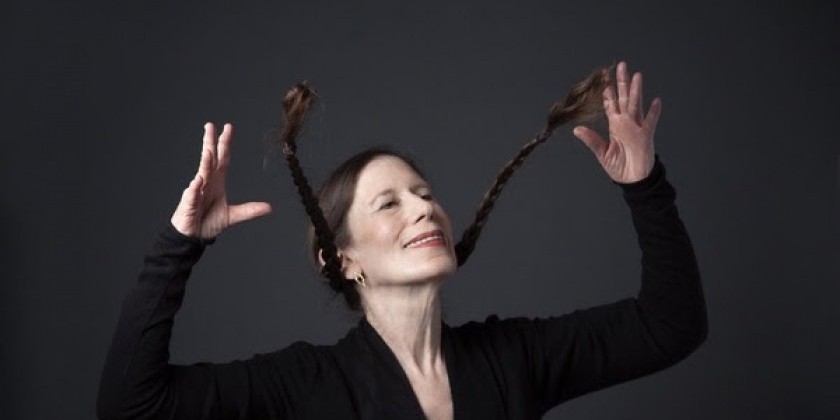IMPRESSIONS: Meredith Monk’s “Cellular Songs” at BAM Harvey

March 14, 2018
Conception, composition, and direction: Meredith Monk
Costume design and scenography: Yoshio Yabara
Lighting: Joe Levasseur
Sound: Eli Walker
Performers: Ellen Fisher, Katie Geissinger, Meredith Monk, Allison Sniffin, Jo Stewart
Public discourse has taken a dizzying turn toward the coarse and the confrontational. Words are hurled like hammers, their purpose blunt, uncompromising — to hurt someone. The old chestnut of “if you don’t have anything nice to say, don’t say anything at all” feels quaint, a relic from the past.
How refreshing, then, it is to see Meredith Monk’s Cellular Songs where she barely says a word, which is not to say that she says nothing. A world premiere at BAM, the piece ritualizes kindness through clear imagery and subtle harmonies.

Monk, childlike at 75 with schoolgirl braids and small bones, remains one of the preeminent music-theater inventors and practitioners. Weaving together syllabic vocalizations, everyday movement, and spare design, she creates multi-layered, heavily textured works that invoke the poetic inexplicability of life itself.
Cellular Songs exists as a gallery of roving miniatures. In one, Jo Stewart and Ellen Fisher banter with youthful inflections and hip-hop gesticulations. In another, Monk, Allison Sniffin, and Katie Geissinger lean forward while vocalizing “hey” as if they’re trying to connect to someone or something beyond their reach. Near the end, all five sit in a ring of chairs that face outward, a circle turned inside out, welcoming rather than restricting. Like a patchwork quilt, each section is distinct yet integral to the whole.

The performers’ vocal articulations may register as babies’ babbling, yet they affect a discrete mood. Ranging from alien warbling to brisk clucking, the songs, when performed by multiple voices, organize into thick harmonies or bounce around like pitched electrons. My ears, striving to unify sound into significance, often hear things that aren’t there. The dancing, though, full of trance-like spins and commonplace gestures, acts as a reminder that meaning isn’t always forged through literal forms.
The sole text to officially appear is based on the sentence “I’m a happy woman.” Monk stands in a rectangle of white light while Sniffin plays piano upstage. Monk recites the phrase but replaces “happy” with other adjectives: tender, hungry, sassy. To be a woman, which is to be human, is to be someone who contains many, sometimes contradictory, incarnations.

Even with poignant scenarios such as when everyone crowds around the piano or Fisher impressively planks on a chair, Cellular Songs begins to blur together, at first incrementally and then suddenly. A projection of hands — one opens the piece too — swathes the stage. We’re full circle where steepling the fingers or caressing the palms symbolizes what the singing suggests.
Yet we’re not. For another ten minutes or so, the performers produce more of the same, seemingly unchanged by the swell of emotion that capped their prior experiences. Then, it becomes apparent why. Ten tweens and teens enter, and everyone lies in the fetal position — seeds about to flower interspersed with those who’ve already flowered.
The circle completes. Kindness is a curve, not a line.
The Dance Enthusiast Shares IMPRESSIONS/ our brand of review and Creates Conversation.
For more IMPRESSIONS, click here.
Share your #AudienceReview of performances for a chance to win a prize.













